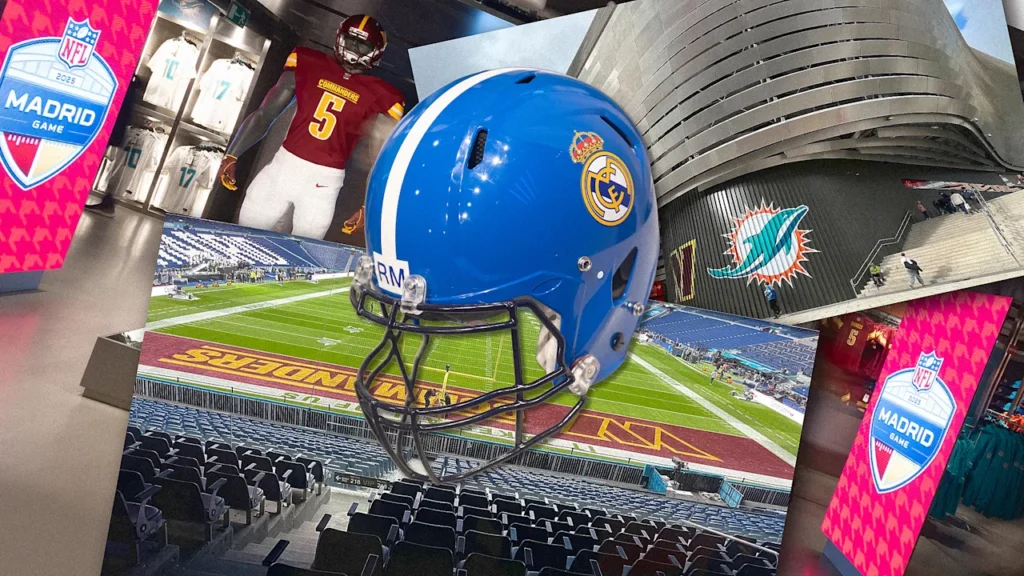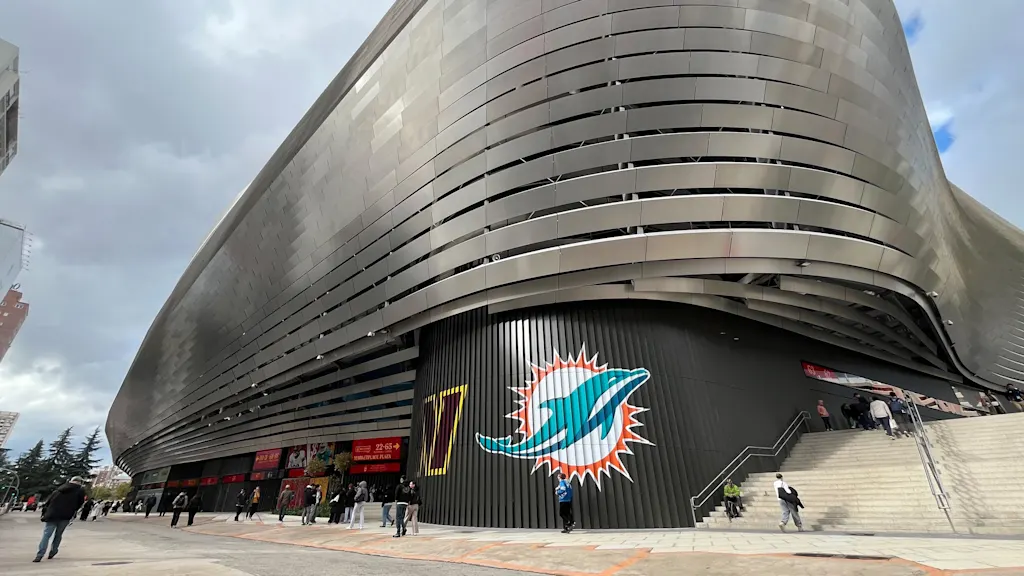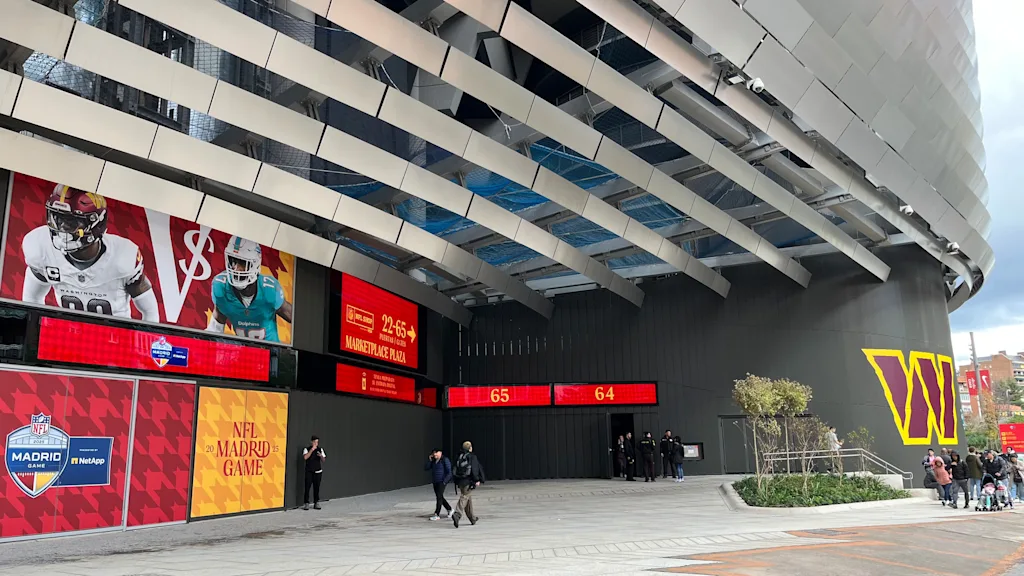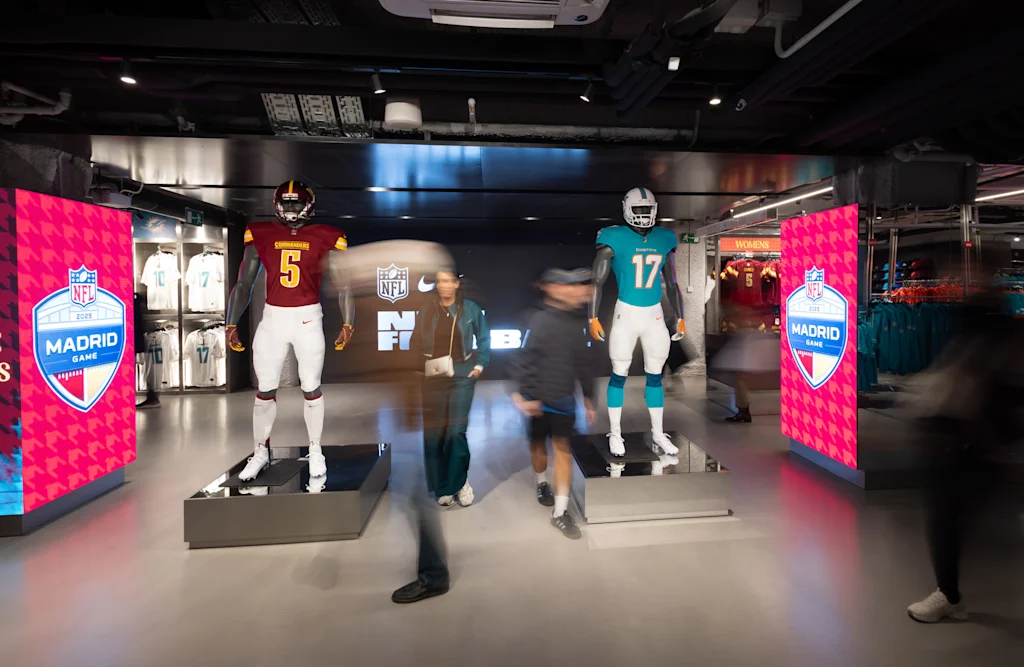
New locker rooms. Rows of seats removed. Every last Real Madrid sign hidden from sight. These are just some of the measures the National Football League took to transform one of the world’s most iconic soccer stadiums for a matchup between the Miami Dolphins and the Washington Commanders. On November 16, the two teams will compete on the field of Real Madrid’s Santiago Bernabéu, though the pitch won’t look anything like its usual self.
To get the field ready, the NFL spent $2.32 million on a series of temporary renovations. The most fundamental change was to the playing surface itself. Since soccer pitches are shorter than American football fields, the playing field had to be extended from 115 yards to the official NFL length of 120 yards. To make this happen, entire rows of seats in the stadium’s North and South Stands were physically removed.

The fact that this could be done at all is a testament to the clever modular work by L35 Architects; von Gerkan, Marg and Partners (gmp) Architects; and Ribas & Ribas Architects, who designed the stadium. Also important is the stadium’s patented, retractable pitch, which is divided into six sections and can be moved horizontally and vertically using electric motors and hydraulic systems. The sections are stored in an underground chamber called the Hypogeum, where the grass is attended to. The Bernabéu’s unique retractable pitch system makes it arguably the most versatile large-scale entertainment venue in the world; it can transform to host soccer, football, tennis, basketball, concerts, conventions, or almost any other event you can imagine.
The logistical needs of NFL teams also forced significant, albeit temporary, structural changes. The locker rooms were expanded to handle the 53-man rosters and their extensive support staff (more than double Real Madrid’s 25-man soccer squad). Because the traditional central tunnel used by soccer players was unsuitable for so many people to go through in a timely, organized manner, new access points to the locker rooms were created in the corners of the bench areas. The league also installed a new, separate press room to meet its specific media protocols.

Unlike soccer, where teams occupy designated benches, NFL teams are positioned along the length of the field. The narrower NFL field width meant the front rows of the side stands did not need to be altered, but the home and visitors’ team boxes had to be removed to make space for the halftime-show stage.

The NFL even tried to fix the stadium’s noise problems, which became known worldwide thanks to Taylor Swift (and, months later, caused Real Madrid to cancel all future music concerts until a solution to the acoustic pollution is found). That in itself is remarkable. And necessary: While Real Madrid games cause extraordinary noise for 90 minutes, the NFL game will cause a lot more because of its halftime show. The NFL installed noise-absorption panels throughout the stadium, probably hoping to avoid the PR backlash that would have ensued (and still might) without them.
Wow
As someone who lives close to the Bernabéu, I’ve been watching the transformation closely. I went to the stadium to see all the changes just before writing this article, and the most shocking thing—at least for a Real Madrid fan like me—was to see every trace of my club erased. All club shields and branding are either covered up or removed entirely. Signs for the NFL, the Commanders, and the Dolphins are everywhere, just as they are throughout Madrid, thanks to the regional government, which spent about $3.5 million to promote the event.
During the game, the stadium’s 1,120-foot, 350-degree screen—which is the spectacular ever-present visual frame for every Real Madrid home match—will display the flags of Spain, the United States, and the NFL, plus all the sponsors and game information. Even the club’s public-facing commercial spaces have been repurposed; the Bernabéu museum, which displays all the trophies and historic memorabilia of FIFA’s Club of the Century since its 1902 foundation, ceded space for a temporary NFL museum. The official team store also gave up a large portion of its retail area for a merchandise shop selling gear from all 32 NFL franchises.
Everyone in Spain is betting on this being worth the money and the effort. Certainly, it will be for fans and curious people: About 84,000 will fill the stadium after the initial sale window saw 700,000 different devices attempting to purchase tickets. The regional government estimates that the game will bring in approximately $81.2 million in revenue.

It is yet to be seen whether it will be worth it for football itself. While the NFL is the highest-grossing sport in the U.S., it pales in comparison to the globally popular game of soccer. According to Deloitte’s 2024 fiscal year report, in Europe alone the soccer market generated revenue of $45.1 billion compared to the NFL’s $23 billion.
Still, all of Madrid has seemingly been swept up by the current spectacle. Just yesterday, my son and I were amazed to see a giant double-decker bus for NFL fans decorated with Miami Dolphins colors. All around the city there are flags and bus stop ads announcing the game. According to NFL executive Jon Barker, bringing football to a wider audience is generational work. “I don’t think at this point that we have any idea 100 years from now what football is going to look like on a global scale,” he told The Washington Post.
The league views this game as a pivotal moment for its expansion into the Spanish-speaking market. A flashy show, for sure. A mini Super Bowl of sorts. But the NFL has an uphill battle if it wants to make a dent in the markets where real football—the one you play with your feet, not with your hands—is the undisputed king.